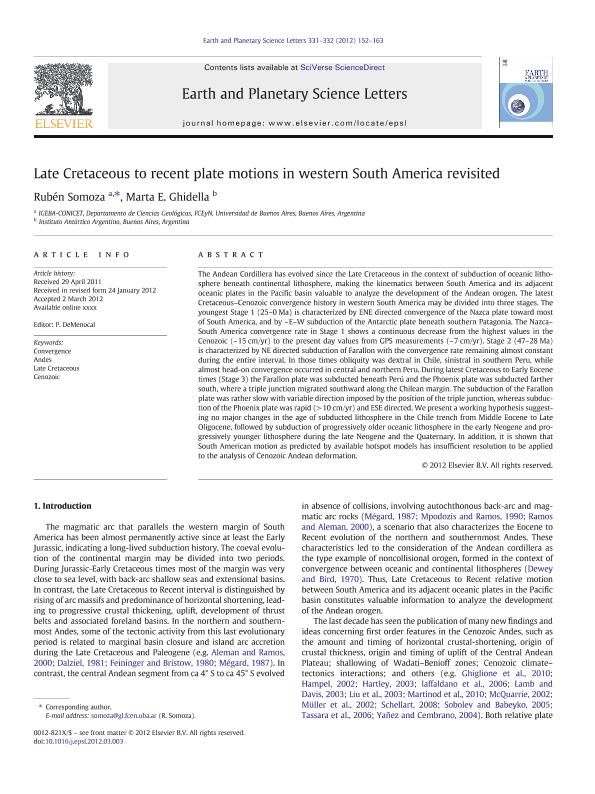Mostrar el registro sencillo del ítem
dc.contributor.author
Somoza, Ruben

dc.contributor.author
Ghidella de Hurtis, Marta Elba

dc.date.available
2019-01-17T20:06:20Z
dc.date.issued
2012-05
dc.identifier.citation
Somoza, Ruben; Ghidella de Hurtis, Marta Elba; Late Cretaceous to recent plate motions in western South America revisited; Elsevier Science; Earth and Planetary Science Letters; 331-332; 5-2012; 152-163
dc.identifier.issn
0012-821X
dc.identifier.uri
http://hdl.handle.net/11336/68224
dc.description.abstract
Se determina y discute la convergencia de placas en el margen occidental de América del Sur entre el Cretácico más tardío y el Reciente
dc.description.abstract
The Andean Cordillera has evolved since the Late Cretaceous in the context of subduction of oceanic lithosphere beneath continental lithosphere, making the kinematics between South America and its adjacent oceanic plates in the Pacific basin valuable to analyze the development of the Andean orogen. The latest Cretaceous–Cenozoic convergence history in western South America may be divided into three stages. The youngest Stage 1 (25–0 Ma) is characterized by ENE directed convergence of the Nazca plate toward most of South America, and by ~ E–W subduction of the Antarctic plate beneath southern Patagonia. The Nazca–South America convergence rate in Stage 1 shows a continuous decrease from the highest values in the Cenozoic (~ 15 cm/yr) to the present day values from GPS measurements (~ 7 cm/yr). Stage 2 (47–28 Ma) is characterized by NE directed subduction of Farallon with the convergence rate remaining almost constant during the entire interval. In those times obliquity was dextral in Chile, sinistral in southern Peru, while almost head-on convergence occurred in central and northern Peru. During latest Cretaceous to Early Eocene times (Stage 3) the Farallon plate was subducted beneath Perú and the Phoenix plate was subducted farther south, where a triple junction migrated southward along the Chilean margin. The subduction of the Farallon plate was rather slow with variable direction imposed by the position of the triple junction, whereas subduction of the Phoenix plate was rapid (> 10 cm/yr) and ESE directed. We present a working hypothesis suggesting no major changes in the age of subducted lithosphere in the Chile trench from Middle Eocene to Late Oligocene, followed by subduction of progressively older oceanic lithosphere in the early Neogene and progressively younger lithosphere during the late Neogene and the Quaternary. In addition, it is shown that South American motion as predicted by available hotspot models has insufficient resolution to be applied to the analysis of Cenozoic Andean deformation.
dc.format
application/pdf
dc.language.iso
eng
dc.publisher
Elsevier Science

dc.rights
info:eu-repo/semantics/openAccess
dc.rights.uri
https://creativecommons.org/licenses/by-nc-sa/2.5/ar/
dc.subject
Convergencia
dc.subject
América del Sur
dc.subject
Nazca
dc.subject
Cenozoico
dc.subject
Cretácico Tardío
dc.subject.classification
Meteorología y Ciencias Atmosféricas

dc.subject.classification
Ciencias de la Tierra y relacionadas con el Medio Ambiente

dc.subject.classification
CIENCIAS NATURALES Y EXACTAS

dc.title
Late Cretaceous to recent plate motions in western South America revisited
dc.type
info:eu-repo/semantics/article
dc.type
info:ar-repo/semantics/artículo
dc.type
info:eu-repo/semantics/publishedVersion
dc.date.updated
2019-01-16T18:18:30Z
dc.journal.volume
331-332
dc.journal.pagination
152-163
dc.journal.pais
Países Bajos

dc.journal.ciudad
Amsterdam
dc.description.fil
Fil: Somoza, Ruben. Consejo Nacional de Investigaciones Científicas y Técnicas. Oficina de Coordinación Administrativa Ciudad Universitaria. Instituto de Geociencias Básicas, Aplicadas y Ambientales de Buenos Aires. Universidad de Buenos Aires. Facultad de Ciencias Exactas y Naturales. Instituto de Geociencias Básicas, Aplicadas y Ambientales de Buenos Aires; Argentina
dc.description.fil
Fil: Ghidella de Hurtis, Marta Elba. Ministerio de Relaciones Exteriores, Comercio Interno y Culto. Dirección Nacional del Antártico. Instituto Antártico Argentino; Argentina
dc.journal.title
Earth and Planetary Science Letters

dc.relation.alternativeid
info:eu-repo/semantics/altIdentifier/doi/https://doi.org/10.1016/j.epsl.2012.03.003
dc.relation.alternativeid
info:eu-repo/semantics/altIdentifier/url/https://www.sciencedirect.com/science/article/pii/S0012821X12001173
Archivos asociados
